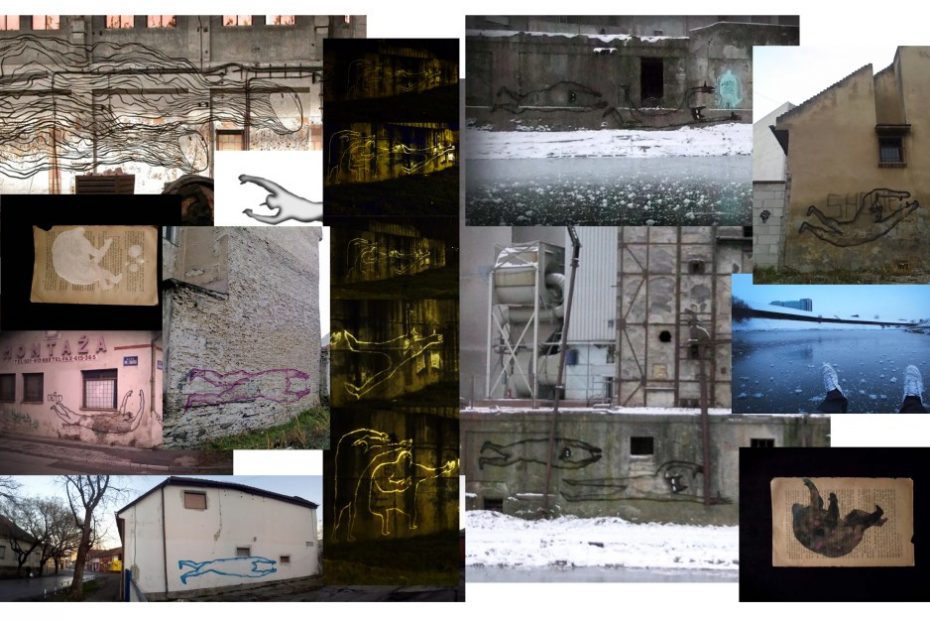Floating Bstrd, the nom de crayon of Marko Vuleta Djukanov, is the veritable essence of Belgrade’s thriving club scene. His flyers, vinyl record sleeves and band posters explode with bold colors and a retro-futurist sensibility that blends influences from ’80s and ’90s design, pop culture, and the raw energy of the avant garde Yugoslav Black Wave cinema.
Born in 1985 in Zrenjanin, when the country was still called Yugoslavia (it’s now Serbia), Djukanov lives and works in Belgrade, where he has cemented his influence. Djukanov has designed work for some of the biggest names in electronic music, including Larry Heard, Jeff Mills, Laurent Garnier, Ritchie Hawtin, DJ Deep and others. Beyond his visual work, Djukanov is also a co-founder of Karmakoma, a revered underground nightclub in Belgrade, for which many of the posters below were made.
His whirlwind output, beginning when he was creating street art, is the subject of this exclusive interview.
Floating Bstrd street art.
How long have you been making posters as Floating Bstrd?
… Floating Bastard as a name stuck from one specific series of street art drawings named like that (see above). I think the year was 2008–2009.
[The] “almost strictly poster” period of my career came after I decided to end my journey that went from small and big marketing agencies, design studios, festivals, IT startups, etc. The year was 2016. I was always closely connected to the music world so it felt natural, and the amount of work back then was just enough to focus only on that. Making a leap was a no-brainer from my perspective. Also, the artistic approach that I’m interested in is not always easy to get the green light from clients, and I like to have my way when it comes to art; the music industry (at least the one I’m connected with) still respects individuality/the personal touch.
I see a number of influences in your work. What has inspired you, and why?
Well, my fascination with poster art as a medium started in high school (I attended graphic design high school) when my poster professor Doru Bosiok introduced us to Polish posters and works of Roman Cieślewicz and Henryk Tomaszewski, theater posters of that time, Yugoslav film noir posters, etc. That resonated with me instantly and lots of influences from that time stayed with me since. And probably will forever.
Thinking about it, I [should] have a story here for each name and influence that moved me since I usually go to great depths of research when someone’s work or way of thinking intrigues me. In order to keep this text within reasonable reading length, I will just write down some great minds that I looked up to growing up: Roman Cieślewicz and Henryk Tomaszewski, Lella and Massimo Vignelli, Milton Glaser, Mirko Ilic, Charles and Ray Eames, Paula Scher, Vico Magistretti, Seymor Chwast …
Tell us more about Karmakoma.
It’s co-funded with Nemanja and Strahinja from Drugstore club, the main and biggest techno club in Belgrade, and Sacha Mambo, the head of Macadam Mambo record label from Lyon. The name [Karmakoma] came as an homage to a Massive Attack/Tricky album that I spent years listening to as a teenager. I also really liked the wordplay of it, but in a way of the club being a safe space where your bad karma can’t get ya (the word karma is usually used in a bad connotation, at least around here).
Is there a style of music that your posters best represent?
Hmmm, well, since I have a few different ‘styles’ that I evolve around, I’ll try to pick a few songs that [embody] some of them, if that makes sense.
2: Jasper van’t Hof’s Pili Pili – “Be In Two Minds”
4: Larry Paul Emmett – “Evita” (this one also has a beautiful backstory)
7: Rez Videogame Music – Level 5 Adam Freeland – “Fear is the Mindkiller”
What has been the response to your prolific amount of work?
“Where do you find time to do all of this stuff?!”
You mentioned to me that you’ve been involved in protesting government corruption. What has been going on in Serbia, and how have you engaged?
In November 2024, protests started in Novi Sad after a canopy at the railway station collapsed, killing 15 people and seriously injuring two others. By Feb. 2, the protests had spread to all cities and towns across Serbia and are still going strong. University students are leading the protests, demanding accountability for the collapse.
The protests began with blockades at schools, starting on Nov. 22 at the Faculty of Dramatic Arts, after students were attacked while holding a silent tribute for the victims of the Nov. 1 incident. Since students have been blocking the universities, our club decided to throw parties and donate all the profits to support them so they can get food and other things they need during this time.
What is next for you?
Right now, I’m working on my usual poster projects and some vinyl covers, but I’m also trying to make time to organize a new exhibition series since I’ve got a ton of new work from the past three years. Exciting things are coming, so get ready, everyone!
The post The Daily Heller: Floating Bstrd’s Posters Define Belgrade’s Music Scene appeared first on PRINT Magazine.
